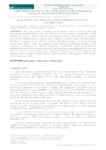Use este identificador para citar ou linkar para este item:
http://www.alice.cnptia.embrapa.br/alice/handle/doc/1073269Registro completo de metadados
| Campo DC | Valor | Idioma |
|---|---|---|
| dc.contributor.author | PEQUENO, I. D. | pt_BR |
| dc.contributor.author | TURCO, S. H. N. | pt_BR |
| dc.contributor.author | SILVA, T. G. F. da | pt_BR |
| dc.contributor.author | FACO, O. | pt_BR |
| dc.date.accessioned | 2017-07-27T11:11:11Z | pt_BR |
| dc.date.available | 2017-07-27T11:11:11Z | pt_BR |
| dc.date.created | 2017-07-27 | pt_BR |
| dc.date.issued | 2017 | pt_BR |
| dc.identifier.citation | Engenharia Agrícola, Jaboticabal, v. 37, n. 2, p. 226-235, mar./abr. 2017. | pt_BR |
| dc.identifier.uri | http://www.alice.cnptia.embrapa.br/alice/handle/doc/1073269 | pt_BR |
| dc.description | Abstract: This study aimed to modeling and bioclimatic zoning of "Saanen" goat milk production in northeastern Brazil. Data were obtained from a 14-year dairy control program for 246 ?Saanen? goat matrices. Dairy production meteorological influence and mathematical modeling were assessed through statistical analyses such as Pearson?s correlation matrix and path analysis. Bioclimatic zoning for current and future scenarios, with climate changes, were delineated using inverse-square distance (ISD) and spherical model (kriging) interpolations. Results showed maximum air temperature to contribute substantially to goat dairy production; therefore, its modeling was based thereon. Current and future dairy production maps highlighted Maranhão and Piauí as regions of limited ?Saanen? milk production. Furthermore, we should emphasize that temperature rises in further scenarios may have significant impact on the potential of dairy farming for the region under study. | pt_BR |
| dc.language.iso | eng | eng |
| dc.rights | openAccess | eng |
| dc.subject | Zoneamento bioclimático | pt_BR |
| dc.subject | Modelagem | pt_BR |
| dc.subject | Bioclimatic zoning | pt_BR |
| dc.subject | Índice de temperatura | pt_BR |
| dc.subject | Brasil | pt_BR |
| dc.subject | Região Nordeste | pt_BR |
| dc.subject | Path analysis | pt_BR |
| dc.subject | Análise de variância | pt_BR |
| dc.subject | Statistical methods | pt_BR |
| dc.subject | Welfare | pt_BR |
| dc.title | Dairy production of "Saanen" goats based on meteorological variables and future climate scenarios. | pt_BR |
| dc.type | Artigo de periódico | pt_BR |
| dc.date.updated | 2017-07-27T11:11:11Z | pt_BR |
| dc.subject.thesagro | Caprino | pt_BR |
| dc.subject.thesagro | Leite de cabra | pt_BR |
| dc.subject.thesagro | Produção leiteira | pt_BR |
| dc.subject.thesagro | Caatinga | pt_BR |
| dc.subject.thesagro | Método estatístico | pt_BR |
| dc.subject.thesagro | Stress | pt_BR |
| dc.subject.nalthesaurus | Climate change | pt_BR |
| dc.subject.nalthesaurus | Bioclimatology | pt_BR |
| dc.subject.nalthesaurus | Brazil | pt_BR |
| dc.subject.nalthesaurus | Goat milk | pt_BR |
| dc.subject.nalthesaurus | Milk production | pt_BR |
| riaa.ainfo.id | 1073269 | pt_BR |
| riaa.ainfo.lastupdate | 2017-07-27 | pt_BR |
| dc.identifier.doi | http://dx.doi.org/10.1590/1809-4430-eng.agric.v37n2p226-235/2017 | pt_BR |
| dc.contributor.institution | Izaac D. Pequeno, Companhia de Desenvolvimento dos Vales do São Francisco e do Parnaíb (Codevasf) - Petrolina - PE, Brasil; Silvia H. N. Turco, Universidade Federal do Vale do São Francisco (UNIVASF) - Juazeiro, BA, Brasil; Thieres G. F. da Silva, Universidade Federal Rural de Pernambuco (UFRPE) - Serra Talhada, PE, Brasil; OLIVARDO FACO, CNPC. | pt_BR |
| Aparece nas coleções: | Artigo em periódico indexado (CNPC)  | |
Arquivos associados a este item:
| Arquivo | Descrição | Tamanho | Formato | |
|---|---|---|---|---|
| CNPC2017Dairy.pdf | 531,86 kB | Adobe PDF |  Visualizar/Abrir |








